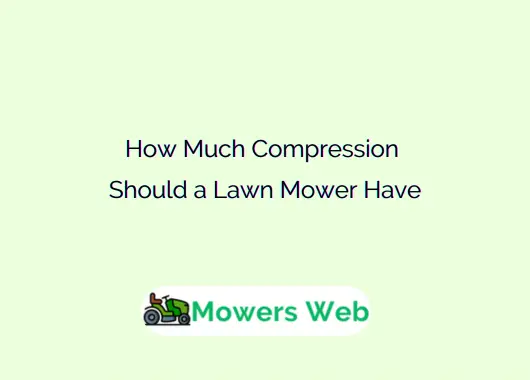When your lawn mower starts becoming difficult to start, loses power, or runs unevenly, one of the most overlooked culprits is engine compression. Compression plays a crucial role in engine performance, determining how efficiently the air-fuel mixture ignites and burns inside the cylinder.
How Much Compression Should a Lawn Mower Have
A healthy lawn mower engine should have around 80 to 100 PSI of compression for modern overhead valve (OHV) engines, while older side-valve engines may run well with 60 to 80 PSI.
Anything below 60 PSI usually indicates a problem such as worn piston rings, a leaking valve, or a blown head gasket.
You can test compression using a gauge screwed into the spark plug hole, crank the engine several times, and read the pressure. Consistent compression ensures efficient combustion, easy starting, and strong engine performance, while low compression causes hard starts, loss of power, and rough running.
Related Lawn Mower Oil Capacity(For ALL Brands + Models)
Ideal Compression for Lawn Mower Engines
So, how much compression should a lawn mower have?
For most small engines, including those made by Briggs & Stratton, Honda, Kohler, and Tecumseh, a healthy compression reading typically falls between:
- 60 to 80 PSI (pounds per square inch) for older side-valve (flathead) engines.
- 80 to 100 PSI or more for modern overhead valve (OHV) engines.
Generally, a compression reading below 60 PSI indicates a problem—most likely a worn piston ring, leaking head gasket, or a stuck valve.
Keep in mind that some small engines have a compression release mechanism to make them easier to start.
This feature momentarily reduces compression during cranking, so if you test the engine with a pull-start, the reading might seem slightly lower than the actual operating compression.
Related What Octane for Lawn Mower(Recommended Rating)
What Is Compression in a Lawn Mower Engine?
Compression refers to the pressure created inside the cylinder when the piston moves upward and compresses the air-fuel mixture before ignition. Proper compression ensures that the mixture burns completely and efficiently, providing enough power to spin the blades and keep your mower running smoothly.
If the compression is too low, the air-fuel mixture won’t ignite properly, leading to hard starts, misfires, or the mower not starting at all. On the other hand, too much compression can also cause issues such as kickback during startup or excessive engine stress.
Related How to Test Lawn Mower Ignition Switch(In 5 Quick Steps)
Signs of Low Compression in a Lawn Mower
Low compression affects how your lawn mower runs. Here are common symptoms that might indicate compression issues:
- Hard to Start or No Start – The engine struggles to ignite the fuel-air mixture, especially when cold.
- Loss of Power – The mower feels weak or stalls under load.
- Rough Idle or Misfiring – Inconsistent combustion causes shaking or sputtering.
- Excessive Fuel Use – The mower consumes more gas than usual without improved performance.
- Hissing Sound – Air escaping from the carburetor or muffler could indicate a valve leak.
How to Test Compression on a Lawn Mower Engine
Performing a compression test is straightforward and can be done with a few basic tools.
Tools Needed:
- Compression gauge (available at most auto parts stores)
- Socket wrench or spark plug wrench
- Clean rag
- Engine oil (optional)
Steps:
- Turn Off the Mower – Make sure the engine is off, the ignition key removed, and the spark plug wire disconnected for safety.
- Remove the Spark Plug – Use the wrench to remove the spark plug carefully.
- Install the Compression Gauge – Screw the gauge’s threaded end into the spark plug hole snugly.
- Crank the Engine – Pull the starter cord several times or crank with the electric starter for 5–7 seconds.
- Read the Gauge – Note the pressure reading on the gauge. A healthy engine should read around 80–100 PSI.
- Repeat for Accuracy – Do the test two or three times to confirm consistent results.
If your reading is below 60 PSI, add a teaspoon of engine oil into the cylinder and retest. If the reading goes up, worn piston rings are likely the cause. If it stays the same, the issue could be a leaking valve or a blown head gasket.
Related How to Tell If Your Lawn Mower Starter Is Bad(5 Signs)
What Causes Low Compression?
Low compression can be caused by several mechanical issues inside the engine. Here are the most common ones:
- Worn or Damaged Piston Rings: Over time, piston rings wear out and fail to seal properly, allowing air to leak past the piston.
- Blown Head Gasket: A damaged gasket between the cylinder head and block can leak air and fuel mixture.
- Bent or Leaking Valves: Valves that don’t seat correctly can cause compression loss.
- Cracked Cylinder Head or Block: Rare but possible, especially if the engine has overheated.
- Carbon Build-Up: Excessive carbon deposits on the valve seats can prevent proper sealing.
How to Fix Low Compression
The fix depends on what’s causing the issue:
- Worn Rings: The cylinder may need to be honed, and new rings installed.
- Leaking Valves: Clean, reseat, or replace the valves.
- Blown Head Gasket: Replace the gasket and check for warped surfaces.
- Carbon Build-Up: Clean the combustion chamber and valves.
For minor leaks or old engines not worth rebuilding, some owners use a small engine oil additive or restorer product to improve compression temporarily. However, this is only a short-term fix.
Related Lawn Mower Smokes When Starting(3 Causes + Solutions)
How to Maintain Good Compression
Preventive maintenance is key to keeping compression at optimal levels:
- Change oil regularly to reduce wear on piston rings.
- Use clean air filters to prevent dirt from entering the cylinder.
- Avoid overheating by ensuring proper airflow and cooling.
- Use quality fuel and add fuel stabilizer if storing the mower for long periods.
- Clean spark plugs and replace them when fouled or worn.
Final Thoughts
Proper compression is vital for a lawn mower’s performance and longevity. Most small engines should maintain at least 80 PSI of compression, though some may still run at slightly lower readings depending on design and condition.
If your mower is hard to start or losing power, a compression test is a simple way to diagnose whether internal engine wear is to blame. Regular maintenance and timely repairs can help prevent costly engine damage and keep your mower running efficiently for years.




